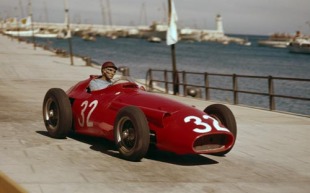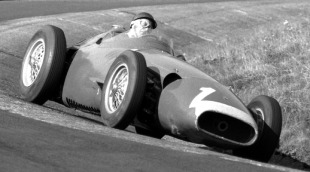
"The nicest Formula One car to drive was probably the Maserati 250F. Obviously a rear-engined Cooper is going to beat it and will be much easier to throw around, but is it as gratifying? Probably not. If one is talking about getting in the car and getting the most out of it with that sense of exhilaration, then, Formula One wise, I would say the Maser was it ." - Sir Stirling Moss.
Recommendations don't come much grander than that, and it goes some way to explaining why the Maserati 250F is often cited as the archetypal front-engined Formula One car. There's no doubt that the all-conquering Mercedes W196 of the same period was a superior machine and the Lancia/Ferrari D50 was certainly more innovative, but the 250F remains the most iconic car of its era.
Statistically, it's hard to understand why. Eight wins from 277 grand prix entries is hardly the stuff of legends and its 220bhp power output wasn't even that impressive in period. But to focus on those numbers would be missing the point. The 250F's appeal is less tangible and best summed up by performances such as Juan Manuel Fangio's at the 1957 German Grand Prix.
By then the car was four seasons old, but in that time it had matured, and in Fangio's hands it could be coerced into performing near miracles. After a botched mid-race pit stop at the Nurburgring, Fangio was nearly a minute behind the Ferrari of Mike Hawthorn, but repeatedly broke his own lap record - which on the morning of the race stood at 9:41.1 - finally setting an incredible time of 9:17.4 on his way to victory and the 1957 drivers' title. The Times described it as "the finest drive of his glorious career".
"When it was all over I was convinced I would never be able to drive like that again - never," Fangio later said. "I had reached the limit of my concentration and will to win."
Undoubtedly, the man behind the wheel was the star, but it still stands that his greatest performance came in the cockpit of a Maserati 250F. The 1957 German Grand Prix turned out to be the 250F's swansong as Maserati pulled out of Formula One in the same year and the car's fortunes were left in the hands of privateers - the very people it had been designed for in the first place.

The Mercedes, with its streamlined bodywork and eight cylinder engine, made the straight-six Maserati look like a Formula 2 car. To make matters worse, Fangio left to drive for Mercedes and duly dominated on the W196's debut at Reims. But rather than leave the fight to the privateers, Maserati, most likely buoyed by the 250F's early success, set up a works team of its own, signing up Alberto Ascari and a promising young driver from Britain called Stirling Moss.
Moss, as his testimony at the top of this article suggests, was immediately at one with the 250F and at the Italian Grand Prix took the fight to Fangio in the Mercedes. However, unreliability, which was a persistent issue in the 250F's first season, struck and he was forced to push the car across the line for 10th place. The 250F had shown promise in its debut season, but as an overall package it was comprehensively outperformed by the Mercedes. It was roughly 40bhp down on the Mercedes and the Germans had started experimenting with windtunnels to streamline its cars while the 250F's profile was still being shaped by the instincts of its designers. In reality it didn't stand a chance.
Mercedes dominated once more in 1955, with the W196 steadily improving while the 250F was somewhat neglected as Maserati focused on its sports cars programme. To make matters worse Moss followed Fangio to Mercedes, although he kept his own 250F - complete with upgraded Dunlop disc brakes - to race privately at non-championship events. A second Mercedes title followed for Fangio, but at the end of the season the German giant withdrew from motorsports in the aftermath of the 1955 Le Mans disaster.

In 1957 Maserati finally gave the 250F the attention it deserved and constructed a new light-weight space-frame chassis. Plans were also put in place for a more powerful V12 engine and, perhaps most significantly, Fangio returned to the cockpit. The 45-year-old piloted the 250F to four wins, including his victory at the Nurburgring, and took the title by 15 clear points.
The V12 engine, complete with a monstrous 320bhp, finally made its debut at the final race of the season at Monza with Jean Behra at the wheel. It proved a bit of an animal and chewed up its rear tyres before retiring with overheating problems, although with a bit of refinement it had the potential to blow the rest of the field away.
However, Maserati closed its racing department in 1957 following a change in its ownership and the Guidizzolo tragedy at that year's Mille Miglia. The remaining 250Fs were sold off to privateers and the cars continued to compete in F1, with 60% of the grid made up of 250Fs at the first race of 1958. The final appearance came in 1960, by which time mid-engined cars had revolutionised the sport and the undeveloped 250F was well off the pace.
In 1962 Fangio's 'Nurburgring' Maserati went up for sale for $3,650. Now it would be worth in excess of $3,000,000. The legend lives on.
Laurence Edmondson is an assistant editor on ESPNF1
© ESPN Sports Media Ltd.
 Laurence Edmondson is deputy editor of ESPNF1 Laurence Edmondson grew up on a Sunday afternoon diet of Ayrton Senna and Nigel Mansell and first stepped in the paddock as a Bridgestone competition finalist in 2005. He worked for ITV-F1 after graduating from university and has been ESPNF1's deputy editor since 2010
Laurence Edmondson is deputy editor of ESPNF1 Laurence Edmondson grew up on a Sunday afternoon diet of Ayrton Senna and Nigel Mansell and first stepped in the paddock as a Bridgestone competition finalist in 2005. He worked for ITV-F1 after graduating from university and has been ESPNF1's deputy editor since 2010

